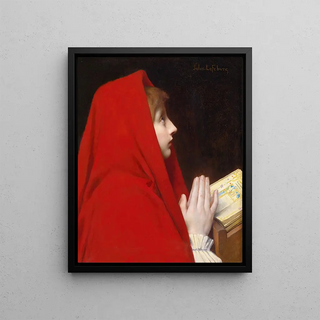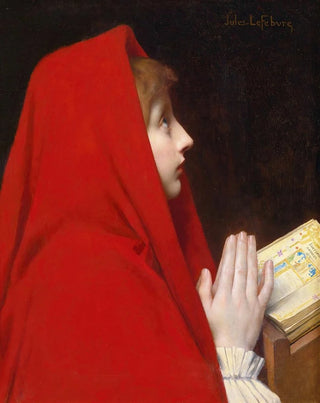Art print | The Red Coat - Jules Joseph Lefebvre


View from behind

Frame (optional)
In the fascinating world of art, some works stand out for their ability to capture the essence of human emotion. "The Red Coat" by Jules Joseph Lefebvre is a perfect example. This canvas, painted at the end of the 19th century, evokes an intimate and richly colored atmosphere, where light plays a fundamental role. The piece features a young woman draped in a vibrant red coat, which immediately draws the eye and sparks curiosity. Through this depiction, Lefebvre succeeds in transcending a simple portrait to offer a true exploration of his model's psychology.
Style and uniqueness of the work
Lefebvre's style is characterized by an impressive mastery of chiaroscuro, giving his characters depth and a palpable dimension. In "The Red Coat," shades of red, white, and black intertwine harmoniously, creating a composition that is both dynamic and soothing. The texture of the canvas, almost tactile, invites the viewer to come closer, to feel the warmth of the coat and the delicacy of the young woman's face. Lefebvre does not merely reproduce an image; he captures an emotion, a frozen moment in time, where every detail, from the gaze to the fold of the fabric, tells a story. This work is a perfect example of how art can evoke deep feelings while celebrating the beauty of the human form.
The artist and his influence
Jules Joseph Lefebvre, born in 1836 in Paris, is one of the most emblematic painters of the French academic movement. His training at the École des Beaux-Arts and his travels in Italy profoundly influenced his style. Lefebvre managed to combine classical techniques with modern sensitivity, which allowed him to stand out in the artistic community of his time. His works, often imbued with romanticism, explore themes such as beauty, femininity, and melancholy. As a teacher, he also trained many artists, contributing to the dissemination of his style and the longevity of his ideas. "The Red Coat" perfectly embodies this duality between tradition and innovation.

Matte finish

View from behind

Frame (optional)
In the fascinating world of art, some works stand out for their ability to capture the essence of human emotion. "The Red Coat" by Jules Joseph Lefebvre is a perfect example. This canvas, painted at the end of the 19th century, evokes an intimate and richly colored atmosphere, where light plays a fundamental role. The piece features a young woman draped in a vibrant red coat, which immediately draws the eye and sparks curiosity. Through this depiction, Lefebvre succeeds in transcending a simple portrait to offer a true exploration of his model's psychology.
Style and uniqueness of the work
Lefebvre's style is characterized by an impressive mastery of chiaroscuro, giving his characters depth and a palpable dimension. In "The Red Coat," shades of red, white, and black intertwine harmoniously, creating a composition that is both dynamic and soothing. The texture of the canvas, almost tactile, invites the viewer to come closer, to feel the warmth of the coat and the delicacy of the young woman's face. Lefebvre does not merely reproduce an image; he captures an emotion, a frozen moment in time, where every detail, from the gaze to the fold of the fabric, tells a story. This work is a perfect example of how art can evoke deep feelings while celebrating the beauty of the human form.
The artist and his influence
Jules Joseph Lefebvre, born in 1836 in Paris, is one of the most emblematic painters of the French academic movement. His training at the École des Beaux-Arts and his travels in Italy profoundly influenced his style. Lefebvre managed to combine classical techniques with modern sensitivity, which allowed him to stand out in the artistic community of his time. His works, often imbued with romanticism, explore themes such as beauty, femininity, and melancholy. As a teacher, he also trained many artists, contributing to the dissemination of his style and the longevity of his ideas. "The Red Coat" perfectly embodies this duality between tradition and innovation.






